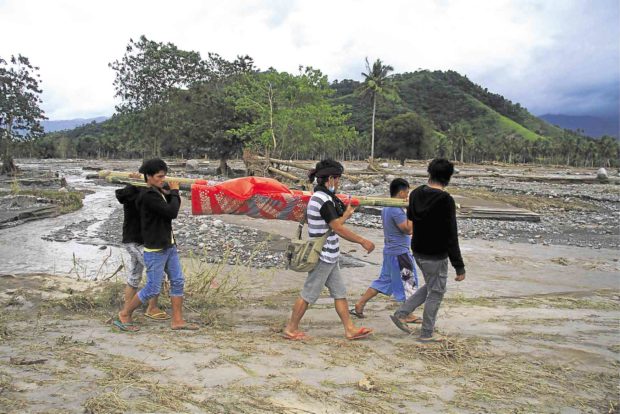
Residents of Sitio Pansor in Salvador, Lanao del Norte, carry on an improvised bamboo stretcher the remains of a child across a shallow portion of a river that swelled at the height of Tropical Storm “Vinta.” —RICHEL V. UMEL
DAVAO CITY — President Rodrigo Duterte attributed the high death toll and widespread sufferings caused by the consecutive typhoons that knifed across the southern parts of the country recently to the refusal of people to move out of high-risk areas.
In an interview in Tubod, Lanao del Norte, which he visited on Wednesday in the aftermath of Tropical Storm “Vinta,” the President said it was “difficult” on the part of the authorities to convince people to leave their properties and seek shelter in safer zones.
“That’s difficult, especially moving people. The usual answer would be [calamities do not happen] often. You would need a lot of convincing (to relocate people),” he said.
Vinta and “Urduja,” the tropical storm that preceded it, damaged or destroyed P1.24 billion worth of agricultural products in Mindanao and Eastern Visayas, according to the Department of Agriculture.
The two typhoons left 286 people dead, with scores of others still missing.
Urduja alone left an estimated P2.17 billion in damage to infrastructure and crops, according to the National Disaster Risk Reduction and Management Council.
Damage to rice and other high-value crops pushed the tally to more than double the initial estimate of P547.74 million as data from heavily stricken areas came in on Thursday.
The President said the loss of lives and damage to properties could have been mitigated if people in high-risk areas had heeded calls to move to safety.
“Human beings are animals of habit… I myself had been a victim of floods but I did not move out [the first time the flood came]. I did not want to relocate because I did not have somewhere to go to,” he said, adding he was a new mayor in Davao then.
He said it was only when the floods inundated his home in Davao a second time and “when the lives of my family [members were] in jeopardy that I said [it was] time to move out. My children nearly died.”
The government’s rehabilitation and relief efforts in calamity-stricken areas, the President said, were swifter this time because he made sure that these were orchestrated by a single official.
This was the reason why he did away with multiagency committees that were not only slow to act but were also prone to corruption, he said.
“It’s faster now because [rehabilitation] is in the hands of [a single person],” Mr. Duterte said, citing the government’s response to the destruction wrought by the five-month fighting in Marawi City.
To speed up the rebuilding of Marawi, the President appointed retired Army Maj. Gen. Eduardo del Rosario to head the city’s rehabilitation task force.
Mr. Duterte said his 23 years’ experience as mayor of Davao City taught him that forming committees to deal with the needs of people affected by calamities “just doesn’t work.”
Unscrupulous people usually meddled in committees such as those organized by local governments, he added.
“It’s (committee) more prone to allowances and everything and corruption in the end. I just appoint one [overseer] and make all undersecretaries of departments in government as… to constitute a unit so it will be quicker,” he said.
Mr. Duterte assured local officials in Mindanao and the affected communities that the “government is working.”
“I would be glad to respond to you,” he told mayors in Lanao del Norte, adding he would like the affected areas “to return to normalcy as soon as possible.”
The agriculture department’s damage assessment on high-value crops like rice accounted for 28,737 metric tons of goods from 58,875 hectares of land, affecting an estimated 40,100 farmers.
Damage to about 50,793 hectares of rice fields alone was estimated at P609.2 million, while those of other high-value crops ran up to P443.9 million, the department said in a statement.
Meanwhile, damage to corn crops amounted to P103.7 million, while livestock and poultry losses reached P6.6 million.
The DA has prepared loan programs for farmers affected by the calamities. Under the Survival and Recovery loan scheme, farmers will be given a grant of P5,000 for fast relief and an additonal P20,000 loan as capital.
Region 8, which consists of Samar, Leyte and Biliran sustained P1.06 billion worth of damage in agriculture and P886 million in infrastructure from Urduja, which left 47 people dead, 44 missing and 78 injured.
Meanwhile, landslides and flash floods caused by Vinta left 164 people dead—65 on the Zamboanga Peninsula, 75 in Northern Mindanao and 24 in the Autonomous Region in Muslim Mindanao.
Damage to agriculture in the Caraga region, Zamboanga Peninsula and Northern Mindanao amounted to P247.4 million. —With reports from Nikko Dizon and Karl R. Ocampo